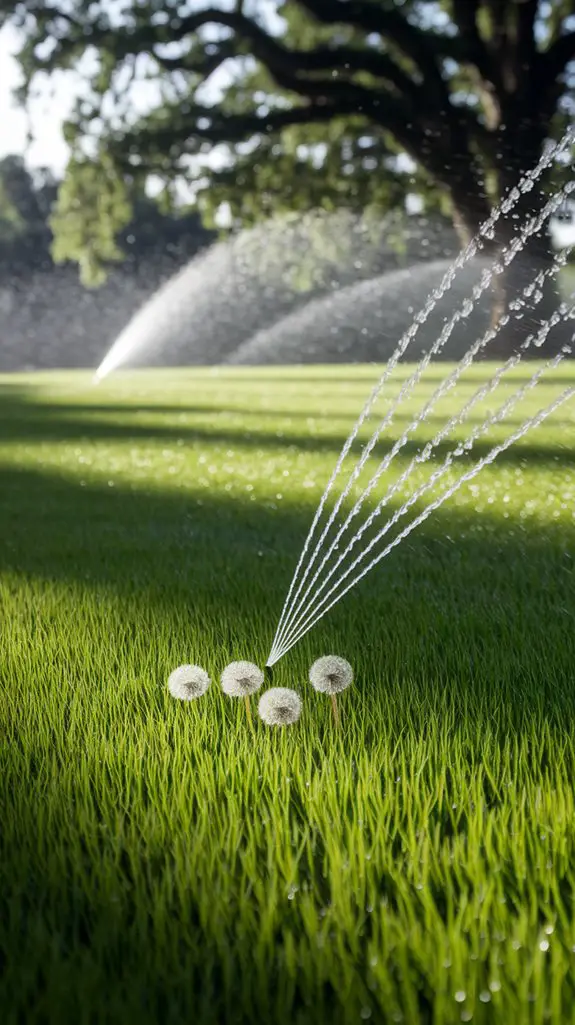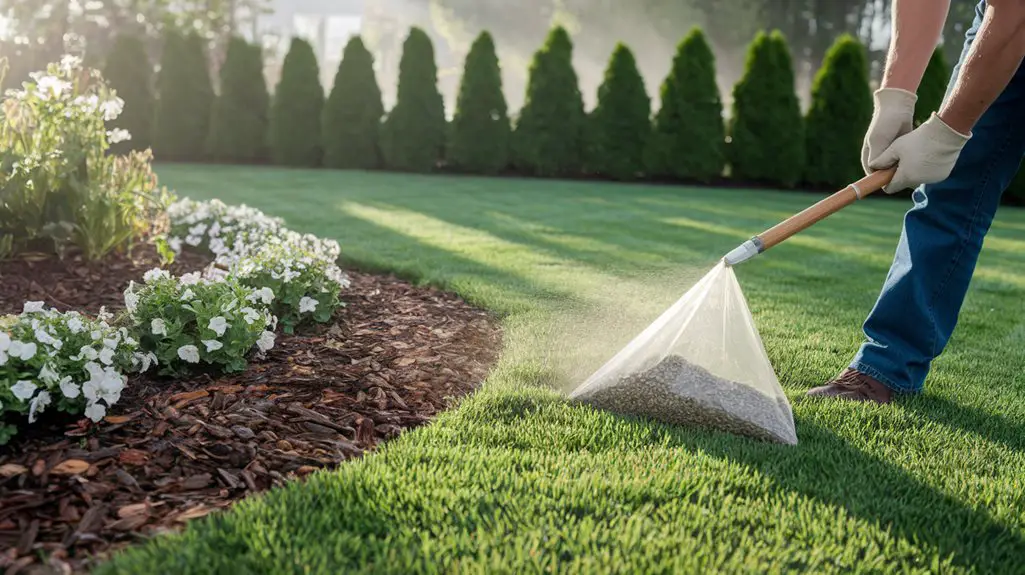Most lawn owners don’t realize that common weeds in their yard are typically indicators of specific soil conditions. Your dandelions might be telling you about calcium deficiencies, while crabgrass points to compacted soil with poor drainage. By learning to interpret these botanical signals, you’ll move beyond simply treating symptoms to addressing the root causes of weed infestations. The strategies you’ll discover won’t just eliminate existing weeds—they’ll transform your entire approach to lawn care.
Understanding Common Backyard Weeds and Their Growth Patterns
Although weeds are often dismissed merely as a nuisance, understanding their biology and growth patterns is essential for effective lawn management.
You’ll encounter three primary weed categories: annuals, biennials, and perennials, each with distinct life cycles that determine ideal treatment timing.
Annual weeds like crabgrass complete their lifecycle in one season, producing thousands of seeds before dying.
Biennials such as wild carrot establish roots in year one and flower in year two.
Perennial weeds—dandelions, clover, and plantain—persist for multiple years via extensive root systems.
Growth patterns vary seasonally: summer annuals germinate in spring, while winter annuals emerge in fall.
You’ll need to identify whether weeds spread through rhizomes, stolons, or seed dispersal to implement targeted control strategies that disrupt their specific reproductive mechanisms.
Proper Mowing Techniques to Discourage Weed Proliferation

Proper mowing techniques serve as your first line of defense against weed invasion, creating conditions that favor grass while inhibiting opportunistic weed species. When you maintain ideal cutting height and frequency, you’ll establish a competitive advantage for your turf.
- Set mower height to 3-4 inches for cool-season grasses, 2-3 inches for warm-season varieties
- Never remove more than one-third of the grass blade in a single mowing session
- Keep mower blades sharp to create clean cuts that heal quickly
- Alternate mowing patterns weekly to prevent soil compaction and grass leaning
- Leave grass clippings on the lawn when they’re less than one inch to return valuable nutrients
These precise mowing protocols strengthen your lawn’s root system while creating dense turf coverage that naturally suppresses weed germination and establishment.
Strategic Watering Practices for a Weed-Resistant Lawn

Strategic watering practices represent the cornerstone of a weed-resistant lawn, directly influencing both turf vigor and weed susceptibility.
You’ll need to water deeply but infrequently—ideally 1-1.5 inches once or twice weekly—to encourage deep root development in turf grasses while discouraging shallow-rooted weeds.
Time your irrigation for early morning (4-9 AM) to minimize evaporation and fungal growth. This timing allows complete leaf drying before evening while maximizing soil penetration.
Avoid frequent, shallow watering that creates ideal conditions for crabgrass and other invasive species.
Consider installing smart irrigation systems with soil moisture sensors to deliver precise amounts of water only when needed.
During drought conditions, allow established lawns to enter dormancy rather than providing insufficient water that benefits weeds more than grass. Additionally, implementing effective irrigation techniques can further enhance the health of your lawn and reduce weed competition.
Soil Testing and Ph Balancing for Optimal Grass Health
Soil testing serves as the foundation of effective lawn care, revealing critical information about your soil’s composition that remains invisible to the naked eye. Most grasses thrive in slightly acidic soil with pH ranges between 6.0 and 7.0, though specific varieties may prefer different levels.
- Collect soil samples from 3-5 locations, 4-6 inches deep
- Submit samples to local extension offices or use reliable home test kits
- Apply lime to raise pH in acidic soils (below 6.0)
- Use sulfur or aluminum sulfate to lower pH in alkaline soils (above 7.0)
- Retest soil every 2-3 years to monitor changes
You’ll notice significant improvement in grass density and color within one growing season after pH correction, while simultaneously reducing weed pressure as grasses outcompete unwanted species in their preferred soil conditions. Additionally, maintaining optimal grass health through proper soil management is crucial for a thriving lawn and minimizing weed growth.
Natural and Chemical Pre-Emergent Weed Control Methods
Implementing pre-emergent weed control methods offers homeowners the most efficient defense against unwanted vegetation before it becomes visible in your lawn. These barriers prevent weed seeds from germinating while allowing established grass to thrive.
For natural solutions, apply corn gluten meal at 20 pounds per 1,000 square feet in early spring. It releases dipeptides that inhibit root formation in germinating seeds. Alternatively, layer newspaper or cardboard topped with 3-4 inches of mulch in garden beds.
Chemical options include prodiamine, dithiopyr, and pendimethalin. Apply these when soil temperatures reach 55°F for crabgrass or 70°F for summer annuals. You’ll need 0.75-1.5 pounds of active ingredient per acre, depending on your target weeds.
Always water in pre-emergents with ¼ inch of irrigation to activate the protective barrier.
Effective Post-Emergent Treatments for Existing Weeds
When weeds have already established themselves in your lawn, post-emergent herbicides become your primary defense mechanism against further infestation and spread.
Select the appropriate formulation based on your specific weed varieties and lawn type to maximize effectiveness while minimizing damage to desirable vegetation.
- Selective herbicides target specific weed types while preserving turfgrass
- Systemic formulations translocate throughout the plant, killing roots and preventing regrowth
- Contact herbicides destroy only the plant tissue they directly contact
- Non-selective options eliminate all vegetation and should be applied with precision
- Organic alternatives like vinegar solutions work best on young broadleaf weeds
Apply treatments during moderate temperatures (65-85°F) for ideal absorption.
Avoid application before rain or irrigation, as this reduces effectiveness and increases environmental runoff potential.
Seasonal Lawn Maintenance Calendar for Year-Round Weed Prevention
A successful weed prevention strategy requires consistent, timely interventions throughout the year rather than sporadic treatment.
Spring (March-May): Apply pre-emergent herbicides when soil temperatures reach 55°F. Overseed thin lawn areas and maintain mowing height at 2.5-3 inches.
Summer (June-August): Water deeply (1-1.5 inches weekly) but infrequently. Apply post-emergent spot treatments for breakthrough weeds. Raise mowing height to 3-4 inches to shade weed seedlings.
Fall (September-November): Apply second round of pre-emergents by mid-September. Core aerate compacted soil areas. Fertilize with potassium-rich, slow-release formula to strengthen root systems.
Winter (December-February): Remove debris and lingering weeds. Plan next year’s treatment schedule. Test soil pH and nutrient levels to prepare for spring applications. Implementing lawn care tips can enhance the effectiveness of your weed prevention strategy.
Overseeding and Lawn Renovation Strategies to Crowd Out Weeds
Dense, healthy turfgrass serves as your lawn’s primary defense against invasive weeds by competing effectively for light, nutrients, and water. Implementing strategic overseeding and renovation techniques creates a robust lawn ecosystem that naturally suppresses weed growth.
- Overseed with premium grass varieties matched to your climate zone during fall when soil temperatures remain between 50-65°F.
- Core aerate compacted soil before overseeding to improve seed-to-soil contact and enhance germination rates.
- Apply a starter fertilizer (higher phosphorus content) immediately after overseeding to promote root development.
- Maintain consistent moisture for 14-21 days post-seeding; water lightly twice daily during germination.
- For severe weed infestations, consider complete renovation: scalp existing turf, remove debris, amend soil pH, then seed.
You’ll achieve maximum weed suppression when overseeding at the manufacturer’s recommended rate, typically 4-8 pounds per 1,000 square feet for most cool-season grasses. Additionally, incorporating lawn care practices that enhance soil health can further bolster your garden’s resistance to weeds.
Conclusion
You’ll win the battle against weeds through systematic lawn care. Test your soil, adjust your pH, and select the right treatments. Mow at proper heights, water at ideal depths, and apply pre-emergents at strategic times. Monitor for emerging problems, address existing infestations, and maintain seasonal vigilance. Implement these methodical approaches consistently, and you’ll transform your backyard from a weed haven into a resilient, thriving lawn ecosystem.




